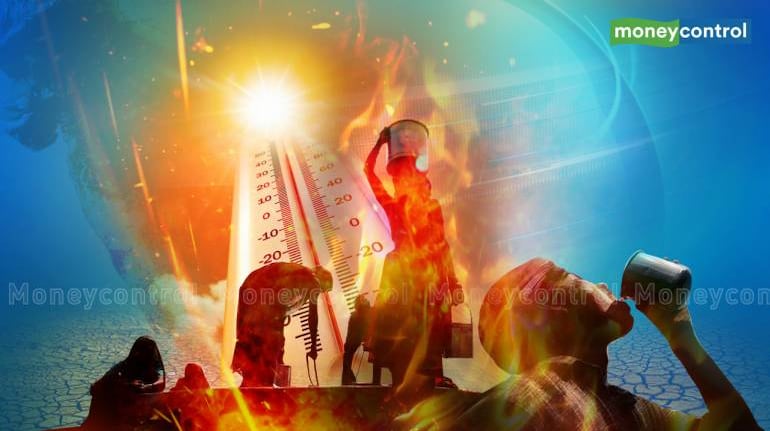Sweltering Summer -Heatwave Scorches India
With unabated heatwave keeping large parts of India simmering, there is a rising number of heat-related fatalities being reported, but a look at the official records throws up a curious contradiction with the data released by various agencies over the years being at odds with each other.
Qualitatively, the India Meteorological Department (IMD) defines a heatwave as a condition of air temperature that is potentially fatal to humans exposed to it. It is defined quantitatively based on the temperature thresholds over a region in terms of actual temperature or its departure from the normal.
The meteorological department considers declaring a heat wave if the departure from normal temperature is more than 4.5 to 6.4 degree Celsius. A departure of more than 6.4 degree Celsius would be considered a severe heat wave.
Rising heat
According to IMD data, the total average annual number of heatwave days in India has risen after 2010. The data, included in the ‘EnviStats India’ report published by the Ministry of Statistics and Programme Implementation (MoSPI), shows the total average number of heat wave days annually in India went up from 90 in 1990-99 to 94 in 2000-09, and rose again to 139 in 2010-2019.
During 2020, 2021, and 2022, a total of 42, 29, and 190 heat wave days were reported, respectively.
“The rising number of heat wave days will result in more deaths every year. Government should carefully plan and implement adaptation techniques, focusing on building public facilities that can offer water and shade to the people outside,” said JK Garg, former Director of the Centre for Disaster Management Studies, Guru Gobind Singh Indraprastha University.
Variations in mortality data
Between 2000 and 2020, India suffered as many as 20,615 deaths because of heat stroke, according to data from the Accidental Death & Suicides in India report published by the National Crime Records Bureau (NCRB). MoSPI has also included the NCRB data in its report. The deadliest year was 2015, when as many as 1,908 people died of heat stroke across the country.
In 2021, as many as 374 people died of heat stroke in India, which is fewer than the 530 recorded in 2020.
However, figures from the NCRB do not match data from the National Disaster Management Authority (NDMA), which shows the number of deaths from heat waves between 2000 and 2020 to be 17,767.
In fact, according to the NDMA, only four people died due to heat waves in 2020 — as many as 526 fewer deaths than the NCRB figure.
In its booklet titled
Beating the Heat: How India successfully reduced mortality due to heat waves, NDMA credits adaptation and mitigation strategies planned by the government for safeguarding the human population from the fallout of heat waves.
“The mitigation strategies are aimed at the prevention of death due to heat waves, preparedness and community outreach. These actions, and the various measures taken by the present government since 2015 at the national level, have resulted in a significant reduction in heat-wave-related casualties,” said the report.
Data from the IMD, which was also included by MoSPI in the 2021 edition of its report, varies from that of both NCRB and NDMA. According to the IMD, between 2000 and 2020, 10,545 people lost their lives to heat waves — only around half the figure cited by NCRB.
Need for standardisation
“The data IMD provides on heat wave mortality is based on media reports. This can lead to a lot of under-reporting. Even NDMA doesn’t have the proper resources for data collection and depends on states to send them. Only NCRB has state and district level bureaus for data collection,” said Anil K Gupta, a professor at the National Institute of Disaster Management.
Although differences in data collection methods and definitions used in categorising deaths may be the reason, such variations in data maintained by government agencies call for greater standardisation, as inconsistencies lead to questions over the credibility of the data.
“These agencies need to coordinate among themselves in order to avoid such disparities in their data. This has been a concern that we have raised even earlier,” said Gupta.
More importantly, despite the inconsistencies, data shows that amid the surging number of days with extreme heat, the average annual mortality from heat waves still remains high compared to earlier decades despite a drop in deaths in the last two years.
Underreporting of deaths
A large number of deaths that are caused by heat waves are not recorded as such, experts say.
“The poorest sections of the population who can’t afford a shelter and stay on the streets are extremely vulnerable during such heat waves. Quite often, when they die, no proper reporting is done. And often some other underlying disease is cited as the reason, although they would have died because of the heat,” said Garg.
“The actual number of deaths due to heat waves annually could increase by as much as five times if all cases were properly reported,” he added.
